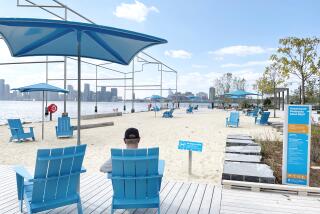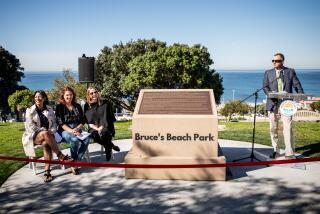N.J. Pushes for Opening Bridge to U.S. History
- Share via
NEW YORK — A couple of generations ago, most people traveled to Ellis Island by huddling for days in the stinking hold of a crowded steamship, with little more than a suitcase full of belongings and a head full of dreams to carry into the New World.
Today, most people visit the island while snapping pictures from the deck of a ferry boat, with little more than a hot dog, frosty drink and maybe a foam-rubber Statue of Liberty crown--one size fits all--to get them through the 10-minute voyage from dock to landmark. If you lean over the railing and stare out to sea, it isn’t hard to conjure a tiny measure of awe the immigrants must have felt when they sailed under the shadow of the statue into New York Harbor.
Soon, tourists may have an even more convenient way of reaching this monument to hardship. If New Jersey is successful in overcoming opposition from New York, Washington and the shuddering ranks of horrified preservationists, people will be able to walk to Ellis Island.
In the latest skirmish over Ellis Island bragging rights, a group of northern New Jersey communities and congressmen are pushing a $2-million plan to refurbish a little-known bridge, now used mainly by construction workers and park employees, and open it to pedestrians next year.
Yet critics consider the idea a sacrilege, tantamount to renaming the place “Elvis Island.”
“Why muck around with something that is as close as we have to a national shrine?” asked Peg Breen, president of the New York Landmarks Conservancy, a group helping rehabilitate the island’s historic buildings. “Why not build a bridge across the Grand Canyon?”
Bridge backers bristle at the idea that walking to Ellis Island is historically incorrect. “Coming by ferry with a hot dog and a beer in your hand is not a historical experience,” said Cheryl Allen-Munley, transportation director for Jersey City, N.J. “If you want to go to Gettysburg, do you have to come by horseback?”
More than 40% of all Americans have ancestors who came through Ellis Island, where immigrants were processed, checked for disease and even tested for idiocy. The 27.5-acre island sits a few hundred yards from the Statue of Liberty.
Last May, the Supreme Court settled a long-standing border dispute by ruling that most of Ellis Island is inside New Jersey, a bruising blow to the Big Apple and a boost to its oft-maligned neighbor, which is anxious to put a Jersey stamp on the place.
Yet, the National Park Service, which actually owns the land, is opposed to opening the bridge to the general public, said Richard Wells, Ellis Island planning and development director.
The rusting 450-yard span was built in 1986 to allow construction employees to restore historic buildings on the island, a $200-million job that continues. Wells said the bridge will have to go someday, in part because it slices away a section of sea wall on the Jersey shore.
And, he said, the $2 million that a north New Jersey regional authority has budgeted for next year still won’t bring the bridge up to building codes.
He also said Ellis Island was picked as the immigrant gateway precisely because it was an island, a place where incoming diseases could be contained. “Connecting it to the mainland by a bridge destroys that character,” Wells said.
Yet, bridge backers hoot at such arguments. In 1995, New Jersey had $15 million in federal money to build a new bridge to the island that would have satisfied any code requirements, they say, and still the Park Service was opposed. “The Park Service is just being obstinate,” said Rep. Robert Menendez (D-N.J.).
Bridge backers say the Park Service, whose employees freely use the bridge to go to and from work, don’t want to share their perk with the huddled masses yearning for free admission. Menendez said a low-income family of four can’t afford the $20 it costs to ride the Ellis Island ferry.
The bridge dispute isn’t the only one on the island. The Supreme Court gave New York three acres of the place, yet a court special master is trying to figure out the exact boundaries. At stake are the gift shop and library, Allen-Munley said, which generate sales and income tax revenues.
Allen-Munley chuckled over the fact that National Park Service offices had to get New Jersey mailing addresses, although they retained New York City phone numbers. Wells stressed that the Park Service office still had a New York address; the New Jersey address is just for the letter carrier.
The liveliest example of New Jersey’s cheek came on July 4, when Gov. Christine Todd Whitman, Sen. Robert Torricelli (D-N.J.) and other officials took the boat to Ellis Island and briefly ran a state flag up a National Park Service flagpole that is now in New Jersey.
The politicos made some speeches, gloated over the Supreme Court decision and fired off a cannon from Liberty State Park in Jersey City. “Don’t be concerned,” Torricelli joked. “It’s not [New York Mayor] Rudy Giuliani trying to take the island back.”
Allen-Munley said the Park Service had tried to block the ceremony and that Torricelli had to call Interior Secretary Bruce Babbitt so the New Jerseyites could have their fun. Wells said the Park Service office initially hadn’t realized that the flag-raising request was coming from the governor.
Among the people who joined the island raid was Owen McCormick, 73, a Jersey City resident raised in New York who came from Ireland via Ellis Island when he was 4 years old.
Contacted about the bridge controversy, he said destitute immigrants had to hire small boats to get off Ellis Island after they were cleared to enter the United States.
“If there would’ve been a bridge there,” he said, “they would’ve taken it.”
More to Read
Sign up for Essential California
The most important California stories and recommendations in your inbox every morning.
You may occasionally receive promotional content from the Los Angeles Times.













